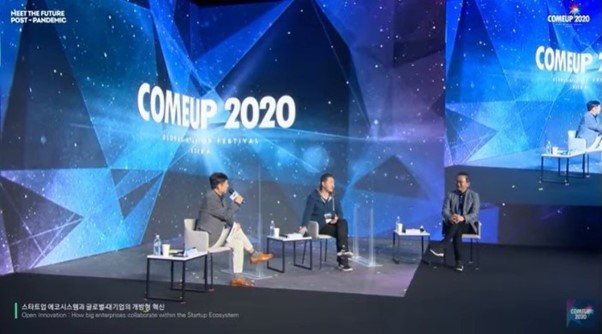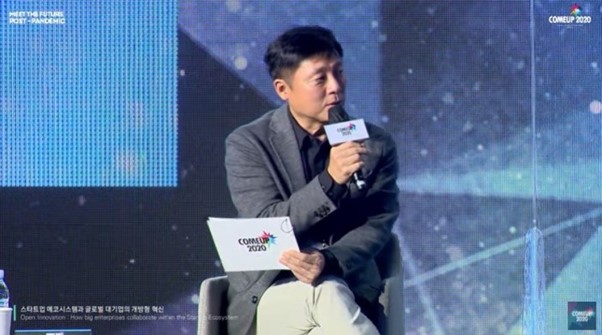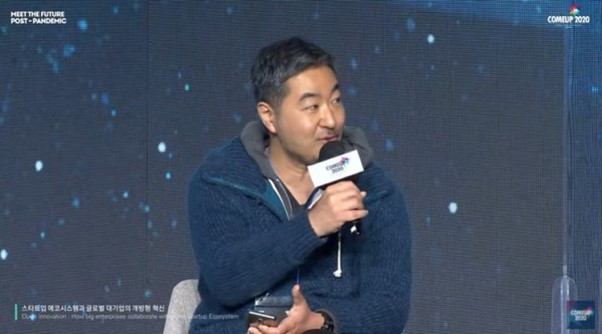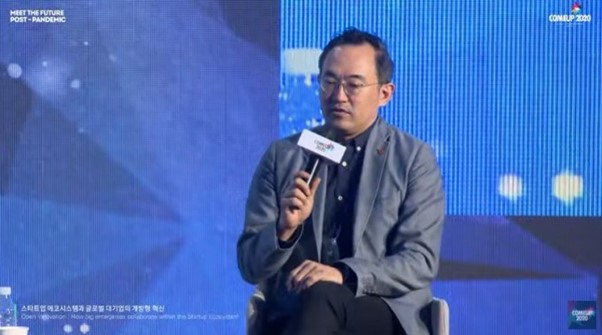The global startup festival “COMEUP 2020” was held at Ilsan CJ E&M Studio for 4 days from the 19th. The event, launched under the slogan “Meet the Future After COVID., had speaker lectures and panel discussions categorized into 3 major topics including “Social System,” “Work,” and “Life,” as well as 12 sessions including “Environment” and “Digital Healthcare.”
In the panel discussion of the Open Innovation session of the second day of the event, opinions on the topic of “Open Innovation: How big enterprises collaborate within the Startup Ecosystem)” were exchanged. Park Young Hoon, Executive Vice President of GS HomeShopping, participated as the chairperson, and Alex Shin, Vice President of LG International Corp., Yang Sang Hwan, the leader of Naver, and Cong-Thang Huynh, the CEO/Co-Founder of Innolab Asia, participated as the panelists.
“We are about to discuss how open innovation theories put together in academia are being utilized in businesses,” Vice President Park Young Hoon opened up. He explained that considering the difficulties in traveling due to COVID-19, questions were delivered to and answers were received from CEO Cong-Thang of Innolab Asia in advance.
CEO Cong-Thang advised that the difficulty in carrying open innovation forward due to the COVID-19 pandemic should be taken as a chance for value creation. He said, “Crisis allows finding more partners and new strategies,” and added, “It provides a chance for corporates to support each other through confirming potentials in long-term relationships and forming partnerships in order to supplement their insufficiency.”
As an example of successful cooperation between a corporate and a startup in Southeastern Asia, Cong-Thang mentioned Shinhan Future’s Lab that was launched by Shinhan Bank and SCG of Thailand that built an open innovation center. He brought out an opinion that Shinhan Future’s Lab played its guiding role as a FinTech supporting model to attract investors and connect with a startup sufficiently. In the case of SCG of Thailand that Cong-Thang worked with as partners, he introduced their propulsion with research & development (R&D) in private sectors and the education industry by putting in a huge capital, as well as their corresponding establishment of innovation network that makes commercialization possible.
He highlighted 3 things as open innovation trends. He explained that participating cocreation is being led with increasing participation of consumers and that crowd funding, as well as cooperation between corporates and cities, is becoming a trend.
Lastly, Cong-Thang asserted that with respect to the cooperation between the corporates of Southeast Asia and Korea, an ecosystem should be established by utilizing resources within Korea and cooperating with competent partners. He mentioned that if connected with a large are partner such as Innolab Asia, Vietnam’s innovative ecosystem can be used as a pilot project and be applied through this connection. He gave advice that cooperation of all interested parties is important and that a policy for the government to supervise the overall situation should be prepared for a more dynamic open innovation.
“For corporates that have internal limitations when preparing an open innovation, they should think about the meaning of having to give it up or lessen it,” he continued. He then asked the other two panelists what kind of influence open innovation is getting under the assumption that another incident like the current pandemic situation can occur.
To this question, Vice President Alex Shin agreed that open innovation has subsided due to limitations in the activities between borders. However, he also explained about positive aspects. By explaining that open innovation is what becomes widely activated to satisfy new markets and customers’ needs, he highlighted the fact that the system of cooperation to solve problems can arise more extensively because of the needs having the same problem. In other words, it is a new chance to provide various responses actively to many startups and large corporate networks.
Leader Yang Sang Hwan showed an agreement. According to Yang, there were stimuli about changes in large domestic corporates before COVID-19, but they never became large-scale. However, afterward, the corporates were stimulated about internal changes even without having to spend much money on consulting. He said that compared to last winter, large corporates had a 25% decrease in business profits but a 15% increase in the amount invested in the first half of this year. However, he added in the place of startups, the possibility of large corporates directly jumping into the vertical market as well as open innovation has increased so it is time for them to recognize the time as a crisis and overcome to proceed.
Yang separately explained precautions for large corporates and startups for doing an open innovation. He revealed that startups should make their plans by linking to survival strategies due to problems like encountering liquidity crises when there is high uncertainty. He said, “The ultimate model of open innovation is mixing blood with each other such as M&S (mergers and acquisitions) and cultures,” and added that “for startups, the ability to design oneself as a merchandise is crucial. The ability to do sales to large corporates that do open innovation is necessary.” He advised that in the place of large corporates, it is better to have a mediator as soon as possible.
Executive Vice President Park asked Vice President Shin about a way to accept cultural gaps that arise in the process of open innovation. Shin pointed out that the speed of communication, the necessity of method improvement, and changes in the executives’ thoughts are also crucial. He also answered that he is trying to listen to external voices such as startups as much as possible and that he is in the act of making a group process accordingly.
During the panel discussion, there was also a mention about “Start-Up”, a TV series that is currently being broadcasted. Park commented that the culture allows people to know about the startup ecosystem is becoming more popularized. Yang agreed. Symbolic icons are made and can help with improving awareness, according to Yang.
Park, by saying that “business models of trading companies also evolve as it has become an internet world,” asked how open innovation will be led between countries and regions.
Vice President Shin answered, “Large corporates are focusing on making environments and platforms that are adaptable,” and added, “The market’s needs have diversified, so customers cannot be satisfied with a single solution. An environment that allows collecting opinions together in order to solve one problem will be made.” He then stated, “Since the COVID-19 pandemic, there are difficulties in local activities, and one way is to actively utilize base infrastructures that corporates have built up locally. There are efforts being made to integrate these.”
To end the discussion, Park said, “I began to think that the startup ecosystem and large corporates’ open innovation are not two separate things,” and concluded, “As a future open innovation and ecosystem participant, there is a need to have an attitude of considering ways to cooperation between startups and large corporates.”




You must be logged in to post a comment.